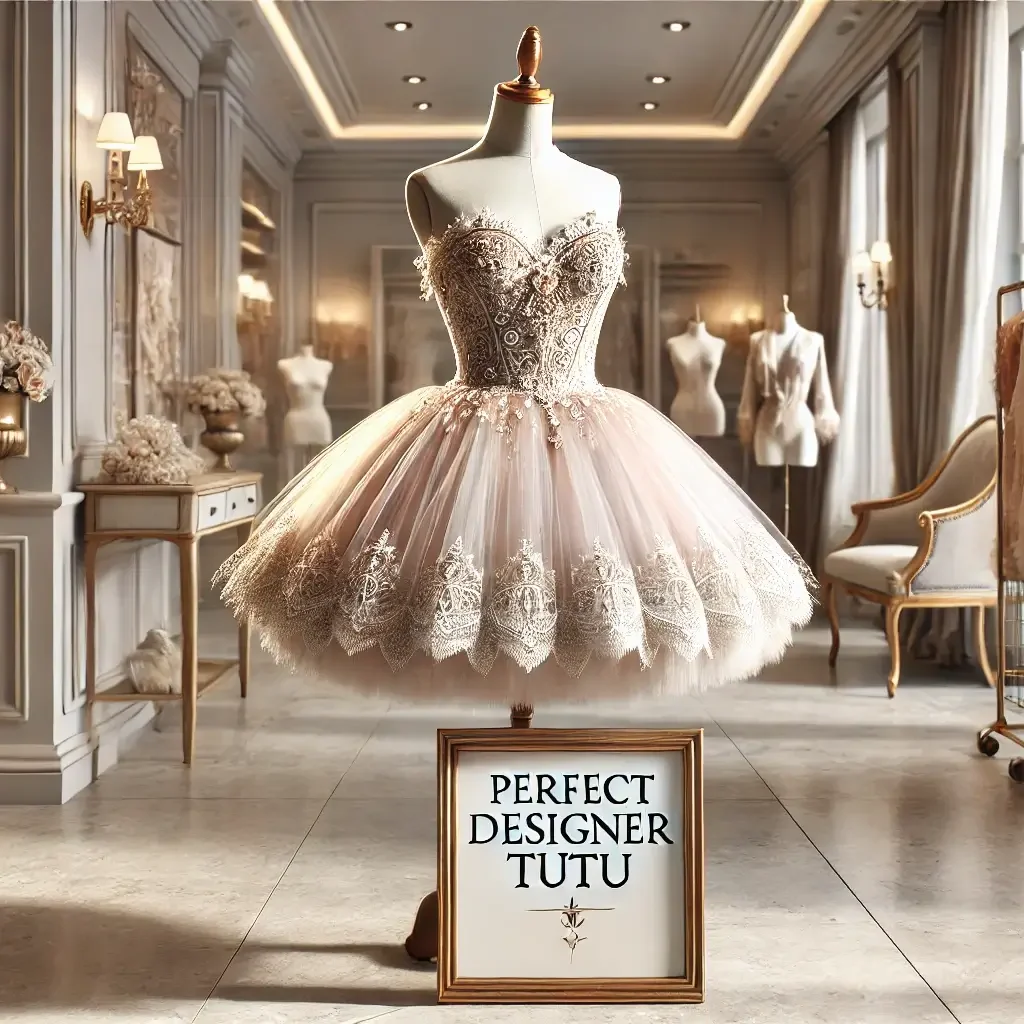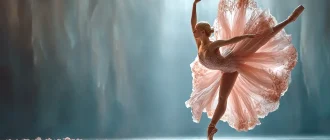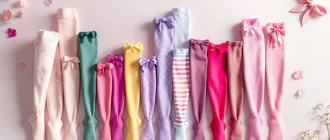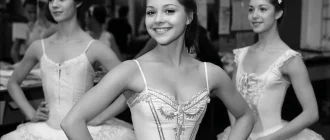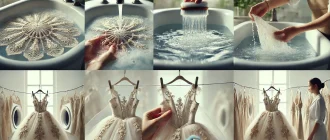What sets a designer tutu apart in the lineup of dancewear and fashion? Precision, personalization, and the pinnacle of performance wear.
This article explains how a designer tutu’s exquisite construction and customized detail make it the choice of discerning dancers and style mavens, whether gracing the ballet stage or punctuating a high-fashion ensemble.
Key Takeaways
- Designer tutus are true works of art, focusing on craftsmanship and detail. They take 20 to 60 hours to create and can be tailored to fit the dancer’s body optimally for performance.
- Custom-made options are available for a unique touch, offering a wide range of styles, colors, and embellishments to fit the dancer’s preferences and the requirements of different performances.
- Tutus are versatile and not just for ballet; modern adaptations have emerged, allowing them to serve as fashionable attire for various occasions and even everyday wear, making them a staple in both performance and fashion.
Exploring the World of Designer Tutus
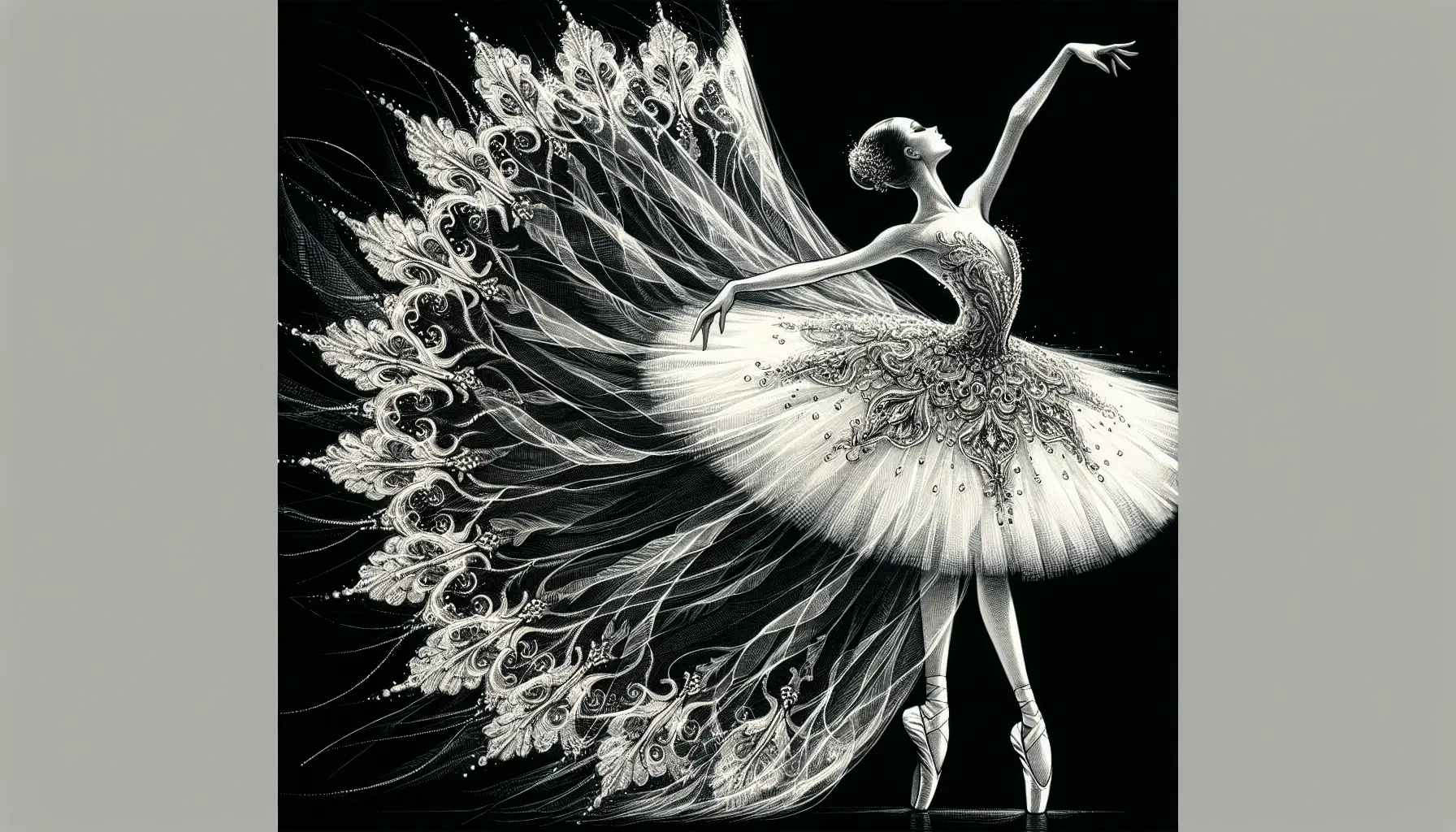
Designer tutus are more than just clothing; they are art. Crafted to make ballerinas feel special and unique, they embody elegance and artistry.
Whether adorning the stage at a ballet performance or adding a touch of whimsy to a birthday celebration, these tutus are as versatile as they are beautiful.
The Artistry Behind Designer Tutus
Every designer’s journey begins with a creative vision, which is translated into comprehensive sketches and prototypes before culminating in the creation of the final garment using premium materials.
Entities like DQ Designs consider creating a tutu an art form that requires meticulous attention to detail and years of expertise.
Crafting a tutu is no simple task. A basic tutu skirt alone can take roughly 20 hours to construct, and due to the extensive handwork required, tutus with elaborate embellishments can take 40 to 60 hours.
Each stitch, bead, and piece of tulle is carefully placed, creating a garment that is a testament to the skill and dedication of its creator.
This artistry isn’t just for the sake of beauty. It also ensures that the tutu fits its wearer like a second skin, allowing them to move gracefully and confidently. This blend of form and function is at the heart of what makes designer tutus stand out from your run-of-the-mill ballet skirts.
Notable Designer Spotlight: Nani Talani
When we talk about the crème de la crème of tutu designers, Nani Talani’s name is sure to come up. Hailing from Ukraine and Portugal, she is acclaimed as one of the best in the business. Renowned for her dedication to ballet, Nani Talani’s tutus elevate the dancer’s performance and the overall spectacle.
Each of her designs showcases her creative genius, spanning a wide range from classical to contemporary ballet styles. Whether a fluffy, romantic tutu or a structured classic, Nani Talani’s creations are revered as masterpieces, reflecting her passion, precision, and profound grasp of ballet artistry.
The masterful tutu designs of Nani Talani highlight the importance of selecting a designer who has a deep understanding of the technical aspects of tutu construction and an intimate knowledge of ballet art. After all, a tutu is more than just a costume; it’s an essential part of a dancer’s performance.
Why Designer Tutus Stand Out
So, what sets designer tutus apart from the rest? For starters, they’re made with the highest quality materials. For example, DQ Designs sources vintage lace and remarkable silks from around the globe to ensure exclusivity and refinement.
However, it’s not just about the materials; how they’re used makes a difference. Some key features of designer tutus include:
- Intricate hand-sewn details
- Customizable designs
- Unique color combinations
- Flattering silhouettes
- Attention to detail in every stitch
These elements combine to create an exceptional piece of dancewear that stands out.
Artisanal methods such as traditional Indian beading techniques are fundamental to Tutu Du Monde’s designer tutus. Each hand-embroidered and hand-beaded piece showcases a dedication to craftsmanship that is simply unparalleled.
This attention to detail extends to quality control measures, ensuring the tutu looks stunning and provides comfort, confidence, and happiness for the wearer.
When deciding on a tutu, the quality of the fabrics and materials used should be a primary consideration.
These elements are pivotal in delivering comfort, allowing extended wear, and guaranteeing the tutu’s durability over time. After all, a designer tutu is more than a garment; it’s an investment in quality and craftsmanship.
Tailored for Twirls: Custom-Made Tutus

For those looking for a tutu that is uniquely theirs, custom-made tutus are the way to go. These tutus are designed to fit each dancer’s measurements precisely, ensuring optimal comfort and mobility.
Creating a custom tutu involves tailoring it to match the dancer’s unique body dimensions and shape. It’s not just about size; it’s about creating a tutu that moves with you.
The Importance of a Perfect Fit
A well-fitted tutu enhances the dancer’s appearance and boosts their confidence. The fit of a tutu affects a dancer’s comfort and confidence, allowing them to perform with greater ease and artistic expression.
A perfectly fitting tutu helps accentuate the dancer’s lines and form, which is crucial for the visual aspect of ballet. It also ensures that no undergarments are visible, maintaining the overall aesthetic of the dancer’s appearance on stage.
Properly fitted dance costumes allow the dancer’s shapes to be seen, which is essential for movement and performance. The bodice of a tutu, shaped like a corset with shoulder straps, must fit snugly so it moves with the dancer without wrinkling.
So, how does one find the perfect fit? It’s essential to refer to the designer’s size guide and take accurate measurements to ensure a proper fit and allow freedom of movement in the tutu. Tailors may request detailed measurement worksheets or even a video of the measurements.
Custom-made tutus offer several benefits for dancers:
- They are tailored to accommodate a dancer’s unique body shape, ensuring a perfect fit and no distractions during performances.
- The process of ordering a custom tutu involves extensive consultations to understand the dancer’s needs, preferences, and the specific requirements of the performance.
- Dancers may need to schedule a fitting several months in advance of their performance to allow for the creation and adjustment process.
The perfect fit is essential for the dancer’s range of motion and prevents wardrobe malfunctions, which can be embarrassing and hazardous. After all, when you’re on stage, the last thing you want to worry about is your tutu!
Personalization Options
In addition to achieving the perfect fit, a custom tutu also offers opportunities for personalization. Custom tutus can be personalized with various colors to match the aesthetic of a performance or a dancer’s preference, offering options beyond the traditional pink and white.
A custom tutu can also be adorned with various embellishments, such as sequins, beads, and lace, to convey the intent of the dance piece and add a touch of character.
But personalization isn’t just about colors and decorations; it’s also about the style and silhouette of the tutu itself. Dancers can choose from varying skirt lengths and bodice styles in their custom tutus to ensure the design aligns with their performance roles and the specific demands of the choreography.
Whether it’s a vibrant red tutu with sparkling sequins for a fiery flamenco routine or a soft pastel tutu adorned with delicate flowers for a spring-themed ballet, the options for personalizing a custom tutu are limitless.
Ordering Your Custom Tutu
The process of ordering a custom tutu necessitates both careful planning and patience. Clients should:
- Place their order well in advance
- Be prepared to pay a deposit, as the creation process is intricate, and designers’ schedules fill up, especially during peak seasons.
- Collaborate on the design, including selecting fabrics and creating skirt samples.
- May receive in-progress updates via social media to involve the client throughout the creation process
Once the tutu is completed, it’s shipped with the utmost care. Designers use express delivery services that include insurance, with the costs determined by the garment’s specifics and delivery requirements. Whether your tutu is traveling across town or the globe, you can rest assured that it will arrive in perfect condition, ready for you to twirl, leap, and shine on stage or at your special event.
A Spectrum of Styles: From Classic to Contemporary
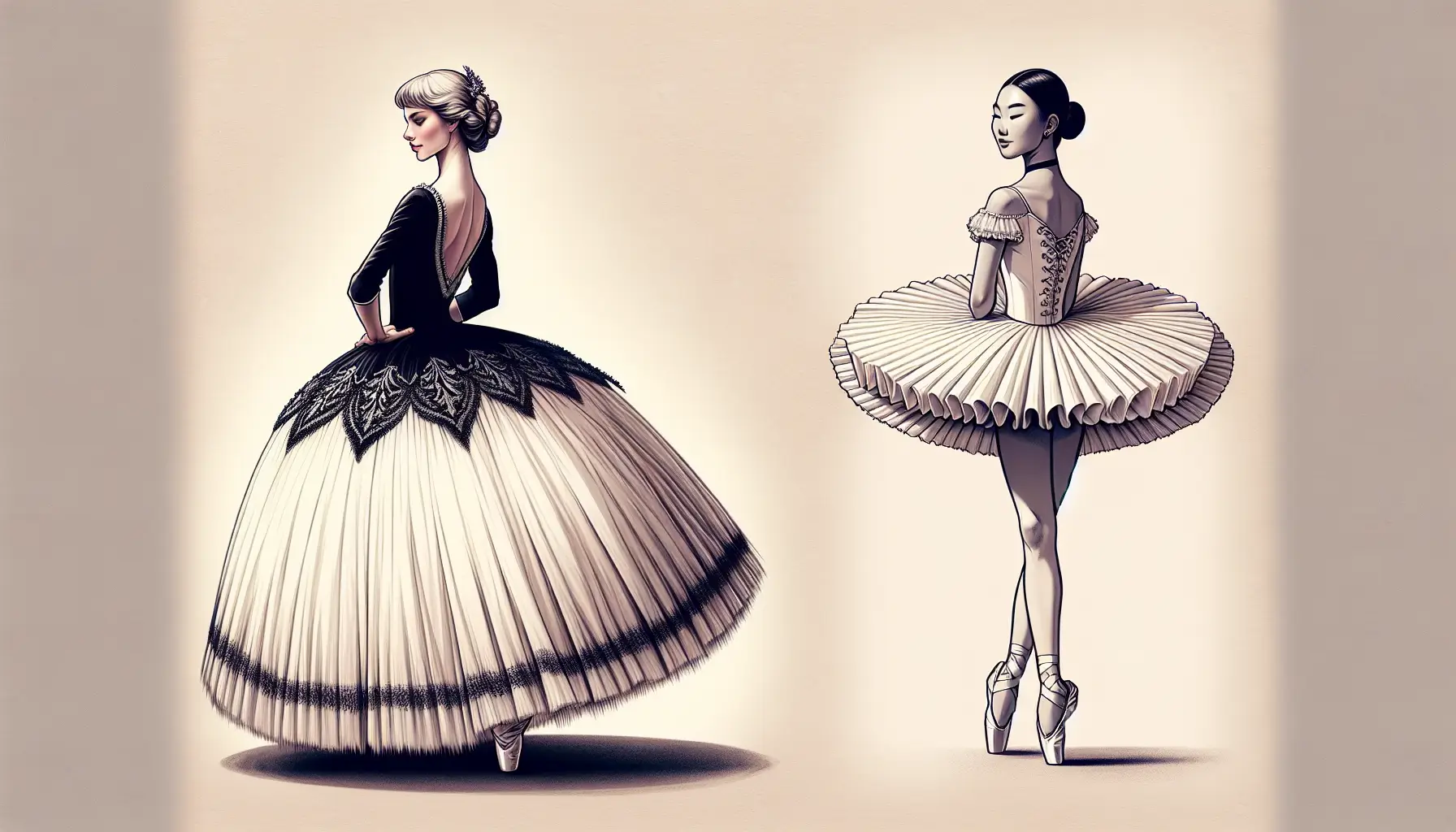
Tutu comes in all shapes and sizes, from classic to contemporary. Thanks to high-end fashion shows like Chanel’s haute couture catwalk, the tutu skirt has been thrust into the spotlight as a major fashion trend. Tutu Du Monde, for example, captures the childhood love of wonder and whimsy with a vintage twist in their world of designer tutus.
When choosing a designer tutu, it’s beneficial to consider designers who offer a range of styles, from traditional ballerina tutus to more contemporary adaptations.
The Timeless Traditional Tutu
The tutu has a rich history. In 1832, designer Eugene Lami introduced the first tutu to the ballet world for Marie Taglioni’s performance in “La Sylphide,” marking the birth of the romantic tutu style. Traditional tutus come in two primary styles: the Romantic and the Classic.
The classic style has four variations: Platter, Pancake, Bell, and Powder-Puff, each serving a unique purpose in ballet performances.
The romantic tutu is characterized by a long, flowing tulle skirt that typically features five to six layers, reaching mid-calf length. This design perfectly captures ballet’s ethereal grace and elegance, making it a beloved choice for many dancers and choreographers.
However, as ballet evolved, so did the tutu. Traditional tutu lengths have been shortened to better display the dancers’ legwork and technical skills in pointe work. This led to the creation of the classic tutu, a shorter and more structured version of the romantic tutu associated with the iconic ballerina image.
Whether it’s the flowing romance of the romantic tutu or the structured elegance of the classic tutu, traditional tutus offer a timeless charm that continues to captivate both audiences and dancers.
Modern Twists on a Ballet Staple
While traditional tutus continue to charm with their timeless elegance, modern adaptations of tutus are making waves in ballet and beyond. The ballet core trend influences modern tutu designs, affecting fabric selection, design details, and the overall aesthetic.
Custom tutu services offer themed designs that reflect the performance’s narrative or emotional tone, adding a unique personal touch to a dancer’s ensemble.
Designer tutus also appear at high-end fashion events and runway shows, highlighting a fusion of modern fashion with classic ballet style.
Designers incorporate additional features, such as embellishments, lace, and themed accents, into their tutus, elevating the traditional ballet staple into a more enhanced visual spectacle.
From couture catwalks to social media trends, modern tutu designs are pushing the boundaries of what a tutu can be. With their innovative designs and fresh takes on this ballet staple, these modern tutus are not just for ballet dancers but anyone who wants to embody the spirit of love and ballet in their daily lives.
Choosing the Right Style for You
Selecting the right tutu style complements a dancer’s body type and amplifies their performance silhouette. Here are some tips for different body types:
- Petite dancers can benefit from tutus with higher waistlines to elongate their legs.
- Dancers with athletic or rectangular body types can opt for styles with ruffles or layers to add curves.
- Dancers with hourglass figures should select tutus that accentuate the waist.
- Pear-shaped dancers can balance their silhouette with A-line tutu skirts.
The torso length of the dancer is a critical factor, which is why a well-proportioned bodice is vital to achieving the desired look. Whether you’re a petite pointe dancer or a statuesque star, the right tutu style will ensure you feel comfortable, confident, and happy during your performances.
However, choosing the right style isn’t just about your body type and performance needs; it’s also about your love of style and comfort. Whether you prefer the classic charm of a traditional tutu or love the avant-garde allure of a modern design, there’s a tutu out there that’s perfect for you.
The Love of Layers: Understanding Tutu Construction
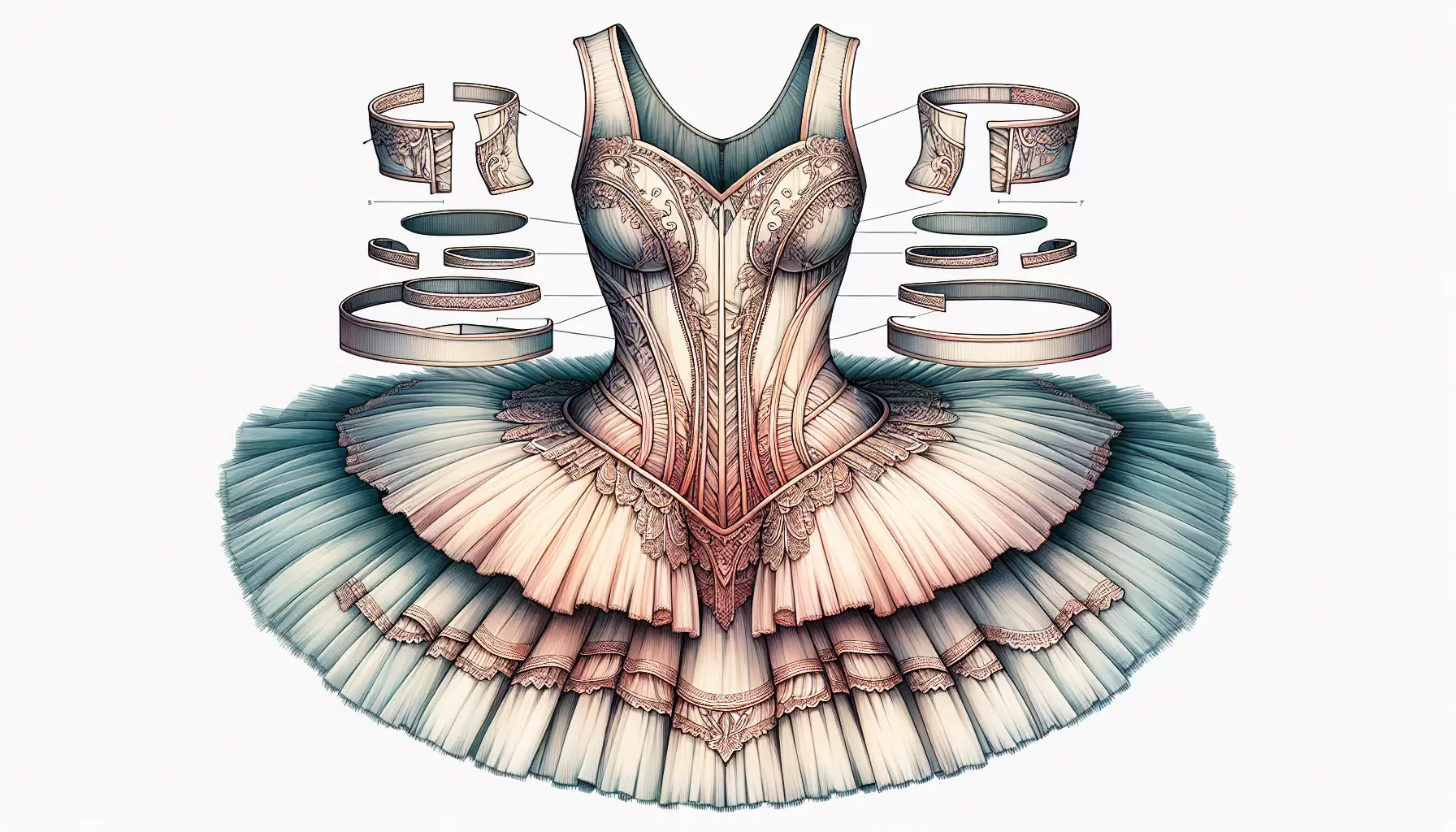
As we continue to explore the world of designer tutus, let’s take a closer look at the intricacies of tutu construction. Professional tutus typically feature ten to twelve layers of netting, while those for amateur use may have only six to eight layers, demonstrating the complexity of tutu construction.
Each tutu layer is carefully attached 15 mm apart on the basque, indicative of the meticulous calculation involved in tutu construction to ensure perfect alignment and a self-supporting structure.
Anatomy of a Tutu
A designer tutu is not just a skirt but a complex garment comprising various components. The bodice of a tutu is often adorned with:
- hand-sewn bead and crystal work
- feathers
- gold appliqué
- sequins
It can require up to a full day’s work to embellish intricately. The basque is the tutu section that extends from the dancer’s waist to the crotch, acting as a stable base to which the tulle and net layers are attached. In structure, it resembles a pair of panties.
To ensure a perfect fit and full range of motion, designers tailor the tulle layers of tutus using the dancer’s precise measurements. Multiple fittings may be required during the crafting process. This combination of detailed design, precise construction, and personalized fitting makes a tutu unique.
Variations in Skirt Structure
The skirt is undoubtedly the most eye-catching part of a tutu and comes in a variety of styles. Tutu skirts typically feature an average of 12 to 16 layers of frills, and for structural support, a hoop may be placed in a casing on the 8th layer. Some common styles of tutu skirts include:
- Bell tutus: made of multiple netting layers without hoop support, they create a soft, rounded bell shape that drapes like a dress and is often used in Russian ballet performances.
- Classical tutus, made of stiff netting layers and commonly seen in classical ballet performances, have a flat, pancake-like shape.
- Romantic tutus are made of soft, flowing materials like tulle or chiffon, creating a more ethereal and romantic look.
There are different types of tutus used in ballet:
- Pancake tutus: These extend outward from the hips and incorporate a wire hoop, creating a silhouette that bounces back after movement.
- Platter tutus: These share similarities with pancake tutus but feature a flat, decorative top layer.
- Powder-puff tutus: These offer a softer, hoop-free design that flows with the dancer’s movements.
Whether it’s the structured elegance of a pancake tutu, the soft flow of a bell tutu, or the fluffy charm of a powder-puff tutu, each skirt structure offers a unique visual appeal and serves a specific purpose in enhancing the dancer’s performance.
Material Matters
The choice of materials plays a significant role in the design and functionality of a tutu. Designer Nani Talani, for example, selects only the finest materials for her tutus to ensure they are not only beautiful but also durable, serving both the aesthetic and functional needs of the dancer.
Tutus incorporate materials like Lycra, which can stretch with dancers’ movements, enhancing fit and comfort. The strategic layering of stiff and soft tulle is crucial for achieving rigidity and fluidity in the skirt.
The choice of fabric can be personalized. Materials like silk or satin offer a luxurious appearance, and lightweight tulle is chosen for its ability to enhance the tutu’s flow and the dancer’s grace.
Modern tutu designs, such as those by Chanel’s Virginie Viard, incorporate fabrics that lend lightness and facilitate movement. This reflects contemporary dancewear trends favoring airy, dynamic silhouettes.
Whether it’s the classic charm of silk and tulle or the modern appeal of Lycra, the choice of materials in a tutu can significantly enhance its appearance, comfort, and performance.
Accessorize Your Tutu: Complementary Add-Ons
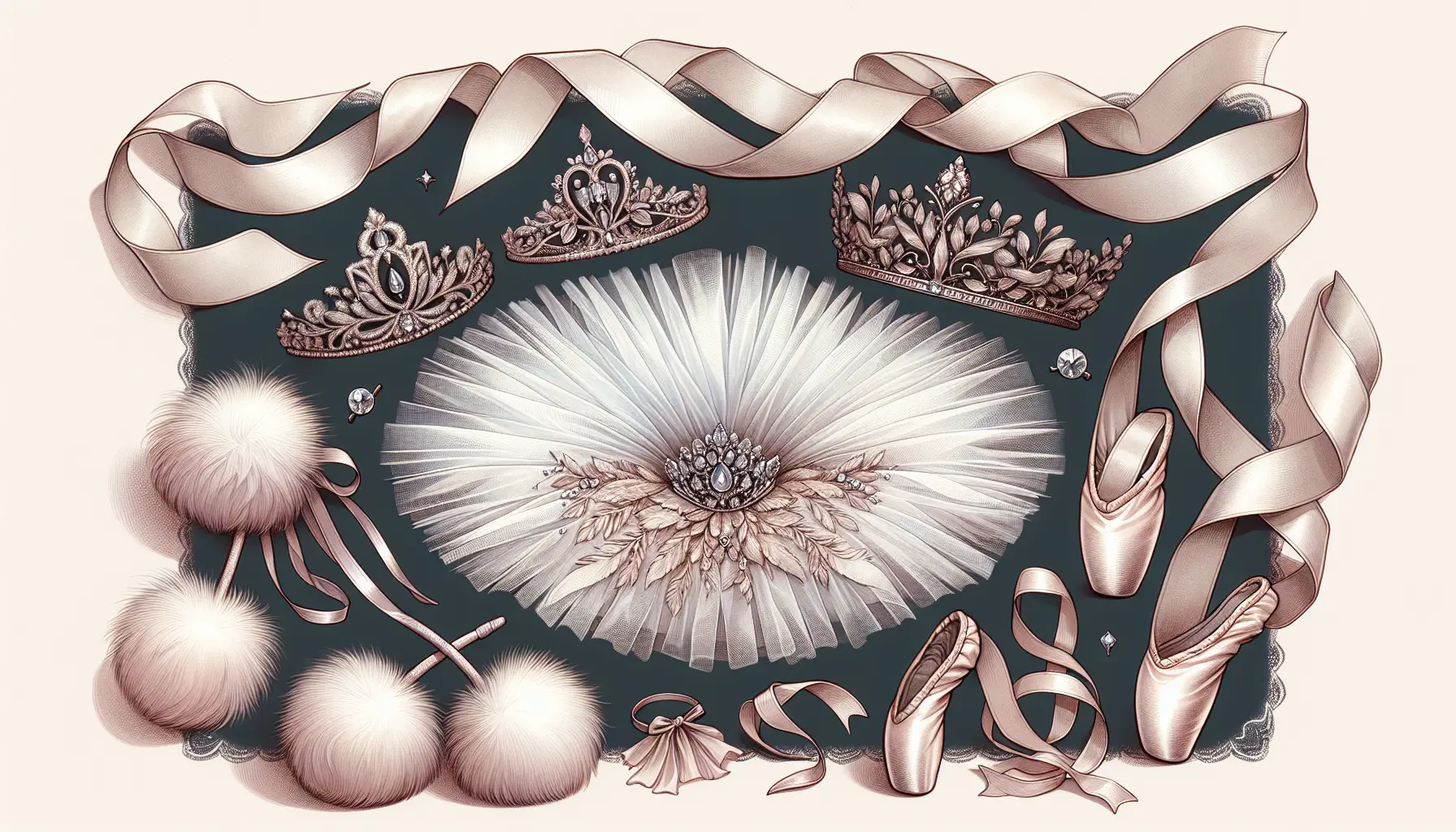
The ensemble of a tutu is incomplete without its complementary accessories. Some essential accessories to complete the ballet ensemble are:
- Headpieces, often adorned with feathers or beads
- Tiaras embedded with crystals
- Ribbons add a delicate touch
- Arm puffs for a dash of elegance
- Swarovski crystals for a sparkling effect
These accessories foster an additional layer of customization and individuality to the tutu.
Proper care, including gentle cleaning and secure storage, is essential for preserving the quality and appearance of tutu accessories, such as headpieces and embellishments.
Headpieces and Tiaras
Ballet headpieces come in various forms, including:
- Tiaras
- Bun wraps
- Crowns
- Hair combs
These options cater to different roles and performance styles. In addition to traditional options, bun wraps add elegance by encircling the dancer’s hair bun. Bridal-style headbands and circlets offer subtly elegant and graceful alternatives.
Designers utilize materials that beautifully reflect light, such as Swarovski crystals, and incorporate decorative elements like feathers and flowers to complement the tutu’s colors and style.
Whether a sparkling tiara for a classical ballet performance or a delicate floral headband for a spring-themed recital, the fitting headpiece can elevate your tutu ensemble to a new level.
Tutu Enhancements: Ribbons and Arm Puffs
Designer tutus are all about the details. Tutus may incorporate up to 100 yards of various materials and are often embellished with diverse decorations like:
- beads
- feathers
- lace
- Swarovski crystals
to create a unique and luxurious appearance. Attaching satin or organza ribbons to a tutu can enhance its elegance and dynamic expression, as flowing extensions complement the dancer’s movements.
Designing arm puffs using the same tulle as the tutu skirt and accentuating them with matching ribbons or lace provides an additional style and uniformity to the ensemble.
Tutu Du Monde’s commitment to ornate detailing is exhibited by its use of traditional Indian beading techniques, where embellishments are meticulously hand-embroidered and hand-beaded, reflecting a high standard of craftsmanship.
Whether it’s a satin ribbon tied around the waist, a pair of fluffy arm puffs, or a scattering of sparkling crystals, the right enhancements can transform a simple tutu into a show-stopping ensemble.
Proper Care for Designer Tutus
As a valuable garment, a designer tutu demands proper care and maintenance. To preserve their shape, designer tutus should be stored upside down, either hung by the crotch or waistband, or placed in a garment bag to protect them from dust and snags. When handling your designer tutu,, make sure you have clean hands and lift it by the waistband to prevent transferring oils and causing edamage to the fabric.
Spot cleaning with a mild detergent mixed with water or a gentle stain remover is recommended if your tutu or clothing gets stained. Remember to use a dabbing motion instead of rubbing to maintain fabric integrity. With proper care, designer clothing, tutus, and clothing made by creators like Tutu Du Monde are crafted to last for years and passed down through generations, adding to their value and sentimental significance.
Proper care for your tutu ensures that it remains as stunning and vibrant as the day you first wore it, whether after a rigorous rehearsal or a dazzling performance.
Dressing the Part: Occasions for Designer Tutus
Designer tutus are versatile costumes for a diverse range of performers, from professional ballet dancers and figure skaters to rhythmic gymnasts. They also add a unique flair to special events, such as weddings and birthdays.
When selecting a designer tutu, it’s crucial to consider one with a reputation for crafting tutus suitable for multiple occasions, blending casual and formal elegance.
Stage-Ready: Tutus for Performances
Designer tutus are crucial in helping dancers embody their characters during performances. For example, the contrast between the White Swan and the Black Swan tutus significantly influences the portrayal and acting of these roles.
Designer tutus are essential for ballet dancers, combining the functionality required for complex movements with the visual appeal necessary for a strong stage presence.
In competitive dance, a designer tutu can set a performer apart through its intricate designs and superior-quality materials, capturing the audience’s and judges’ attention.
Whether it’s a traditional ballet performance, a modern dance competition, or a figure skating showcase, a designer tutu can elevate your performance and leave a lasting impression.
Celebratory Events: Birthdays and Weddings
But tutus aren’t just for the girls who love being on the stage; they can also add a special touch to other girls’ celebrations.
Designer tutus make an adorable and festive outfit for birthday celebrations, allowing young girls to feel special on their big day. Often made with layers of soft tulle and silk, these tutus come in a variety of colors to match any birthday theme.
Designer tutus can be customized for weddings to match the wedding’s color scheme and aesthetic, making them perfect for young attendees. Bridesmaids and flower girls often wear tutus crafted with additional embellishments to complement the bride’s dress and add to the ceremony’s elegance.
A tutu can make the day even more memorable, whether it’s a birthday party, a wedding, or another festive event.
Everyday Elegance: Incorporating Tutus into Daily Wear
Tutus aren’t just for the stage or special occasions; they can also be incorporated into girls’ everyday wear. Designer tutus can be effortlessly matched with fitted tops and skinny jeans to see girls achieve a casual yet stylish ensemble ideal for everyday activities.
A short tutu layered over leggings or jeans offers an option for those girls who prefer to add a touch of femininity while maintaining modesty.
For chillier temperatures, a tutu can be worn with a snug turtleneck sweater, cozy tights, and boots, composing a unique and eye-catching winter outfit. From a casual day out to a glamorous dinner date, the tutu is a versatile fashion item that can be dressed up or down to suit any occasion.
How to Choose the Right Designer for Your Tutu
The choice of the right designer for your tutu can have a considerable influence on your ballet experience. A designer’s reputation in the industry and customer testimonials are strong indicators of their reliability and quality of craftsmanship.
Years of experience can also be vital, as seasoned designers are likelier to deliver high-quality, well-constructed tutus.
The range of styles a designer offers, including traditional and contemporary, might influence the selection of the right designer for your needs. Consider designers who are known for a signature style or those who can offer a portfolio of diverse designs.
Excellent customer service, which includes clear communication and a willingness to collaborate with clients, is essential when choosing a designer. Seek feedback from previous customers to gauge their satisfaction levels and understand their experience with the designer’s customer service.
A designer’s ability to offer custom-fitted tutus ensures a perfect fit, greatly enhancing the garment’s comfort and aesthetics. Check if the designer provides options for customization and personalization, reflecting the wearer’s style and preferences.
Summary
In conclusion, designer tutus bring elegance, style, and artistry to ballet and the world beyond. Whether it’s the artistry of a custom-made tutu, the timeless charm of traditional styles, or the innovative designs of modern adaptations, tutus are more than just a ballet staple.
They’re a testament to the beauty and grace of dance. With the right designer, a tutu can transform every twirl into a moment of magic, whether on the stage, at a special event, or in everyday life.
Frequently Asked Questions
How do you spell tutu for ballet?
Tutu is spelled as “t-u-t-u.” It is a short, classical ballet skirt made of net, worn by ballerinas.
Why is it called a tutu?
The word “tutu” is thought to have originated from the French word “cul,” meaning “bottom” or “buttocks.” It may have evolved from an infantile rendering of the French slang word to become “tutu.” This suggests that “tutu” could be a playful way of referring to “butt butt.”
What is the difference between tutu and tulle?
The main difference between tutus and tulle is that tutus are made from tulle, a thin, net-like fabric. Multiple layers are used to create a substantial skirt, and there are different types of tulle, ranging from soft and airy to stiff.
Who are some famous tutu designers?
One of the world’s most notable tutu clothing designers is Nani Talani, from Ukraine and Portugal. She is known for her dedication and love for the world of ballet and various clothing designs, from classical to contemporary styles.
What makes a designer tutu stand out?
A designer tutu stands out because of its high-quality materials, attention to detail, and artistry in creation. It often features hand-embroidered and hand-beaded embellishments sourced from around the world for exclusivity and refinement.

